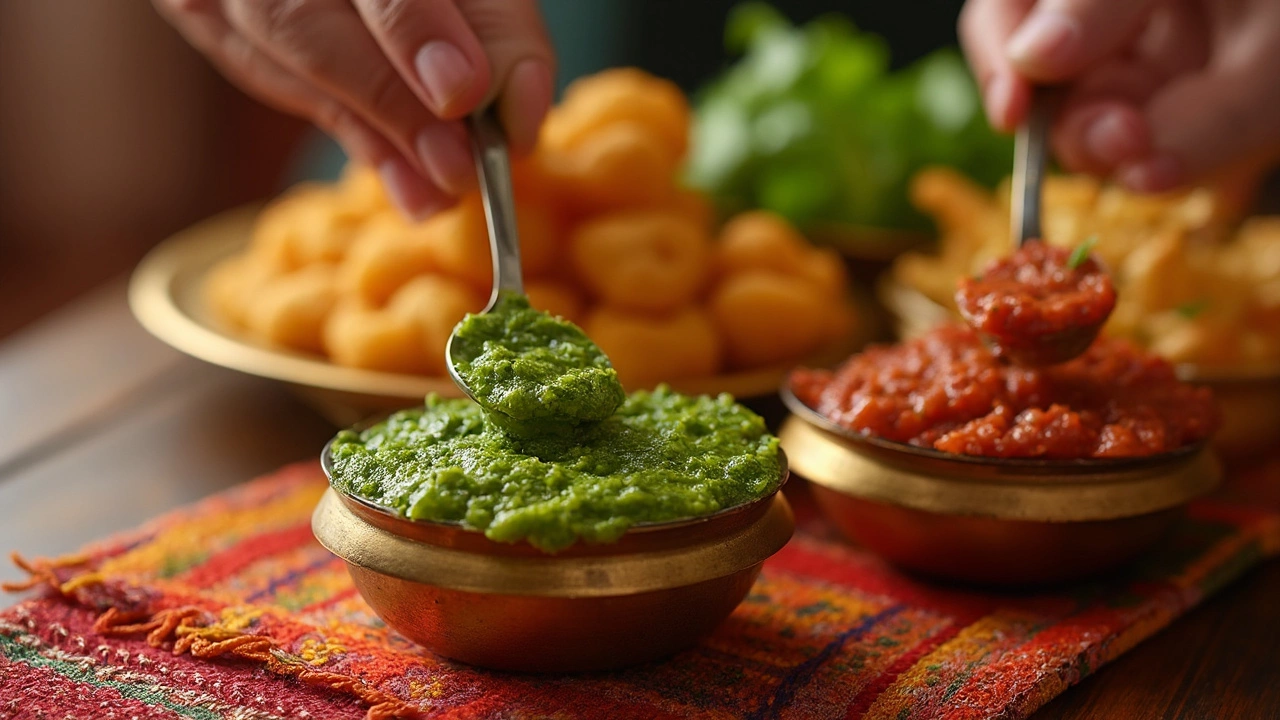Ever dipped your samosa in endless chutney and wondered—wait, should chutney be warm or cold? You’re not alone. It’s one of those classic food debates that can spark a heated argument at any Indian dinner table. Get it wrong, and you might just ruin the vibe of an entire meal.
Here’s the kicker: the perfect temperature actually depends on what’s inside that colorful bowl. Some chutneys do their magic best when they’re chilled, others taste richer when warm. So, before you plop chutney next to your pakoras, it’s smart to know which works when and why. This isn’t just a flavor thing—it’s about texture, aroma, and how it plays with whatever you’re eating.
We’ll break down the science, the old-school traditions, and the real way people eat chutney at home. Plus, I’ll share sneaky tips to keep chutney fresh and full of punch, whether you like it piping hot or ice cold. Ready to finally settle the debate in your family?
- How Temperature Changes Chutney’s Taste
- Classic Chutneys: When to Serve Warm or Cold
- What Dishes Pair Best with Warm or Chilled Chutney
- Tips for Storing and Serving Chutney Just Right
How Temperature Changes Chutney’s Taste
If you think all chutney tastes the same no matter the temperature, you’ve definitely been missing out. Warm and cold chutney has totally different vibes. The secret? Temperature messes with how your tongue and nose pick up flavors, and it can seriously change the whole experience.
Cold chutney, straight from the fridge, keeps its flavors sharp and punchy. Herbal chutneys—like the classic green coriander-mint kind—taste fresher cold because cool temps lock in those leafy notes. And fruity chutneys, like mango or pineapple, also pop more when cold. But here’s the real game-changer: cold chutney usually thickens up, so the texture feels creamier and perfect for dipping.
On the flip side, warming chutney does something totally different. Heating up tomato or tamarind chutney makes the spices and sweet notes come alive. A little warmth releases the natural oils from spices like cumin or mustard seeds. Your kitchen will smell amazing. It also thins down the chutney a bit, so it spreads easier over bread, dosas, or parathas. Ever noticed how steaming idlis paired with warm coconut chutney just feel next level? That’s the temperature making all the difference.
Check out this quick breakdown of how different chutneys change when you serve them warm or cold:
| Chutney Type | Served Cold | Served Warm |
|---|---|---|
| Coriander-Mint | Fresh, sharp, herby | Subtle, less punchy flavor |
| Mango (Sweet/Sour) | Bright, fruity, tangy | Softer, mild aroma, runnier |
| Tamarind/Date | Thick, more syrupy | Spices come forward, tang is milder |
| Coconut | Firm, cool, subtle | Creamier, slightly sweet aroma |
The main thing? Chutney isn’t just a side dip—it actually changes character with the kitchen temp. Warm it up and the whole dish feels heartier and cozier. Serve it cold and you’ll keep things light and zesty. So before you pick your next chutney pairing, think about the temperature and how it’ll land on your taste buds—or your guests’. That alone can take your meal from average to unforgettable.
Classic Chutneys: When to Serve Warm or Cold
There's a lot more to serving chutney than just plonking it on the plate. Different types of chutney have their moment to shine—some right out of the fridge, others just off the stove. Knowing which to pick can really level up your food game and even save you from some classic kitchen mistakes.
Let’s talk about the two main kinds of chutneys you see everywhere: fresh chutneys and cooked chutneys. Fresh ones? Think mint, coriander, or coconut chutney. These are usually made in a blender with raw spices, herbs, and sometimes coconut or yogurt. They taste brighter and sharper when cool—nobody wants warm mint chutney turning into a mushy, dull mess. That's why you'll spot fresh chutney chilling in most Indian homes, especially during summer.
Cooked chutneys work a bit differently. Tamarind, tomato, or classic onion chutneys get slow-cooked to bring out a rich, sweet, or tangy punch. These flavors deepen when the chutney is served warm, especially right after cooking. Ever tasted warm tomato chutney with idlis? There's a reason restaurants keep it on the burner till it’s time to serve.
- Chutney with a lot of herbs (like mint and coriander) – Best served cold or at room temperature.
- Fruit-based chutney (like mango) – Usually cold, but room temperature is okay if you want more aroma.
- Tamarind or onion chutney – Delicious when warm, but can also be served at room temp with fried snacks.
- Coconut chutney – Always cold; warms up and spoils fast if not refrigerated.
Here’s a quick cheat sheet on what’s usually served warm or cold in most Indian households and eateries:
| Chutney Type | Typical Serving Temp | Popular Pairings |
|---|---|---|
| Mint/Coriander | Cold | Samosa, kebabs, chaat |
| Coconut | Cold | Idli, dosa, vada |
| Tamarind | Warm/Room Temp | Pani puri, pakoras |
| Mango | Cold | Rice, grilled meats |
| Tomato | Warm/Room Temp | Idli, rice, paratha |
If you’re in a rush, just remember: anything with fresh greens or coconut gets eaten cold, and the ones that spend time on the flame (like tomato or tamarind) can be served warm. And if you’re hosting? Stick the fresh chutney in the fridge for an hour before eating—it’ll keep the flavors snappy and bright.

What Dishes Pair Best with Warm or Chilled Chutney
Let’s get into the nitty-gritty. Not all chutneys are one-size-fits-all. The dish you’re eating—and the type of chutney you’ve made—should call the shots on whether you go warm or cold.
If you’re serving classic Indian street food like samosas, pakoras, or even dahi puri, you’ll notice most folks prefer their chutney chilled. Cooling yogurt-mint or tangy tamarind chutney hits different when it takes the edge off spicy and fried snacks. Plus, the cold temperature sharpens the flavors and keeps the chutney’s texture fresh and zippy.
But for heavier, heartier Indian meals, things flip. Warm chutney is actually the star with dishes like dosa, idli, or even stuffed parathas. Coconut or tomato chutney, when slightly heated, boosts the aroma and pairs well with hot, fluffy breads or pancakes. There’s science backing this up: warming a chutney can release natural oils from whole spices, making the flavor much bolder. Restaurants, especially in South India, usually serve these chutneys fresh off the stove or at room temperature, not from the fridge.
Here’s a simple table showing classic matches to keep handy:
| Dish | Chutney Type | Recommended Temperature |
|---|---|---|
| Samosa, Pakora, Dahi Puri | Tamarind, Mint-Coriander | Chilled |
| Dosa, Idli, Uttapam | Coconut, Tomato, Onion | Warm/Room Temp |
| Grilled Chicken, Kebabs | Green Chilli, Mango, Cilantro | Chilled |
| Stuffed Paratha, Pulao | Garlic, Tomato, Mango | Warm |
Sandwiches and wraps? Stick with cold—spread chutney straight from the fridge for that cool, bright kick. But if you’re jazzing up a steaming bowl of dal or khichdi, go warm; you want the chutney to blend easily and amp up those homey vibes.
- For crisp, fried snacks, always lean cold. It tames the heat and helps with texture.
- With hot main courses or breads, heating chutney brings out the layers of flavor.
- Some fruit chutneys (like mango or pineapple) work both ways—try them chilled with cheese, or slightly warm over grilled meats.
Pairing isn’t just about taste—it’s about balance. Warm or chilled, the right serving temperature makes chutney the sidekick every meal deserves.
And if you ever forget? Trust your tongue. If hot food and cold chutney feel right, you’re probably doing it just fine.
Tips for Storing and Serving Chutney Just Right
If your chutney game is mostly grabbing a jar from the fridge or slapping it on the table, you might be missing out on the flavors chutney can really deliver. A couple of smart moves will not only help chutney last longer, but make it taste fresher with every meal.
First thing: never store chutney in metal containers. Acidic ingredients like tamarind, vinegar, and tomatoes react with metal and can mess up taste and even safety. Always go for glass jars or clean ceramic bowls with tight lids. If it’s a homemade chutney (think coconut or green chutney), finish it up in 2–3 days. Fruit or vinegar-based chutneys last way longer—sometimes up to a month—if you stash them right.
- Pop homemade chutneys into the fridge within two hours of making them to stop bacteria from moving in.
- When serving, always use a dry, clean spoon. Any bit of water can make chutney spoil crazy fast.
- For fruit chutneys or classic tamarind, serve them cold—they stay tangy and punchy, perfect with fried snacks.
- If you’re pairing chutney with dosa or idli, gently warm coconut chutney. Don’t microwave it—just a quick minute on a stovetop, stirring constantly, wakes up all the flavors.
- If your chutney gets watery after sitting, just give it a solid stir or drain the liquid. Don’t serve the top watery layer, it’s a flavor killer.
"Keeping chutney airtight and dry is the real secret—once moisture or air gets in, it starts fermenting or growing mold pretty fast," says chef Ranveer Brar, known for his practical kitchen hacks.
To make this even easier, here’s a quick peek at best storage and shelf life by chutney type:
| Chutney Type | Best Storage | Usual Shelf Life |
|---|---|---|
| Fresh/Coconut | Fridge (Glass Jar) | 2–3 Days |
| Mint/Coriander | Fridge (Glass Jar) | 3–5 Days |
| Fruit (Mango, Tamarind) | Fridge or Cool Pantry (Sealed Jar) | Up to 1 Month |
| Vinegar-based | Kitchen Shelf (Sealed Jar) | 1–3 Months |
One last thing—don’t freeze chutney if you like texture. Most fresh chutneys turn into soggy mush after thawing. Batch cook only if you plan to finish within the week, and keep those jars tight and dry!
